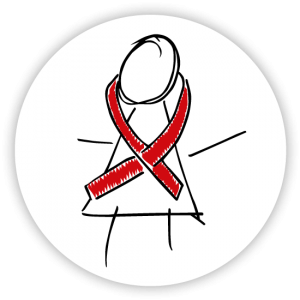Raltegravir in HIV-exposed neonates
1 October 2016. Related: Conference reports, Antiretrovirals, Pregnancy, Paediatric care, Paediatric Workshop 8 Durban 2016.
Daily raltegravir was well tolerated and met pharmacokinetic targets in full term HIV-exposed infants at high risk of infection, in a study presented at the 8th International Workshop on HIV Paediatrics.
Safety and dosing information for antiretroviral in neonates are limited. Raltegravir (RAL) is the first integrase inhibitor to be studied in neonates. It has potential to be used as both as prophylaxis and early intensive treatment in this population.
RAL is largely metabolised by the UGT1A1 enzyme. At birth UGT activity is low and it increases exponentially over the first weeks of life.
Previous research has shown high RAL plasma concentrations in vitro displace unconjugated bilirubin from albumin. This has the potential to increase neonatal risk of kernicterus.
The IMPAACT P1110 study is designed to evaluate safety, pharmacokinetics (PK) and tolerability of RAL oral granules for suspension during the first six weeks of life.
This is a phase 1 study enrolling full-term HIV-exposed, high risk, neonates aged 48 hours or less, with a gestational age of at least 37 weeks and weighing at least two kilograms. Neonates with elevated bilirubin and those receiving phenytoin, phenobarbital or rifampicin are excluded.
Neonates are enrolled into two sequential cohorts: cohort 1 (n=16) receive two single RAL doses one week apart; cohort 2 infants (n=30) receive daily RAL for the first six weeks of life. The initial group of infants are born to mothers not receiving RAL. A subsequent group are born to mothers receiving RAL during pregnancy to delivery.
The investigators combined previously reported PK results from cohort 1 with that from older infants and children enrolled in IMPAACT P1066 in a population PK model and simulations using NONMEM. These were performed in order to develop daily RAL doses to be evaluated in 20 infants in cohort 2.
The investigators noted, developmental changes in absorption and clearance explored, with best fit if: absorption rate changed from 16% of maximum at birth to 90% at two weeks; and clearance changed from almost nil to a maximum at approximately six months of age.
PK targets were: Cmin >33 ng/mL; Cmax <8724 ng/mL; AUC12 (twice daily) 6-20 mg*h/L; and AUC24 (once daily) 12-40 mg*h/L.
The selected cohort 2 doses were: 1.5 mg/kg once daily, birth to day 7 of life; 3 mg/kg twice daily, 1 to 4 weeks of age; and 6 mg/kg twice daily, 4 to 6 weeks of age.
The investigators performed intensive sampling around the initial 1.5 mg dose: pre-dose and 1-2, 4-6, 6-10 and 20-24 hours post dose. Between 15-18 days of life after dose increased to 3mg/kg twice daily, further samples were collected at the same time points. After the second dose, each dose change, and at weeks 5-6 of life after dose increased to 6 mg/kg twice daily, samples were collected pre-dose and two hours post dose.
Data from 12 infants were available: 7 from Brazil, 3 from South Africa and 2 from US; 4 were female and 8 male; their gestational age was a median of 38 weeks and median birth weight 2.8 kg; 4 were delivered vaginally and 8 by caesarean section.
PK targets are: AUC24, 12-40 mg*h/L, AUC12, 6-20 mg*h/L and Cmin 33 ng/mL.
After the first dose of 1.5 mg/kg, geometric mean RAL AUC24 was 37.0 mg*h/L (range 18.6-78.3), 8/12 met target. For 3 mg/kg twice daily the geometric mean for RAL AUC24 was 11.8 mg*h/L (range 4.7-24.5), 9/12 met target. Cmin for 1.5 mg/kg was 833 ng/mL (range 191-2493), 12/12 met target; and for 3.0 mg/kg 120 ng/mL (range 11-666), 11/12 met target.
Sparse sampling confirmed that RAL plasma concentrations were within the expected range. The investigators observed no safety concerns with daily RAL administration through 6 weeks of life.
The investigators concluded that population analysis and simulations has a role in drug development for neonates. They noted that with the initial 1.5 mg/kg dose, Cmin was within target but AUC24 was above target range. But given the rapid increase in RAL metabolism over the first week of life, they considered this exposure to be acceptable.
IMPAACT P1110 cohort 2 in RAL-naive neonates is now closed: 26 infants enrolled as of 27 July 2016. The investigators are doing further modelling to allow enrolment of infants exposed to RAL in utero.
Comment
The study design for RAL, using population PK and simulations to facilitate drug development in neonates is excellent. The design is being adapted for other antiretrovirals to be studied in neonates.
Reference:
Clarke D et al. Raltegravir (RAL) pharmacokinetics (PK) and safety in HIV-1 exposed neonates at high risk of infection (IMPAACT P1110). 8th International Workshop on HIV Paediatrics 15-16 July 2016, Durban, South Africa. Oral abstract O_06.


